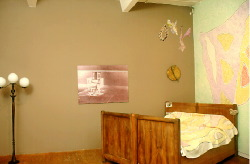Marc Camille Chaimowicz
Norwich Gallery, Norwich, UK
Norwich Gallery, Norwich, UK

Rooms are autobiographies written by their inhabitants - they hint (in their bookshelves, in their laundry baskets, in their stained carpets) at how and why a particular life took on its particular form. The heritage industry is well aware of this, painstakingly preserving the homes of the famous dead, hoping to trap their phantoms in the aspic of historical accuracy. Marc Camille Chaimowicz' show 'Jean Cocteau' at the Norwich Gallery took a somewhat different tack. Here Chaimowicz fashioned a fantasy study-cum-bedroom for the French poet, playwright, librettist, novelist, artist and filmmaker Jean Cocteau (1889-1963). Importantly, most of its contents - objet trouvés, works of art, Chaimowicz' own queer, quasi-domestic creations - post-dated Cocteau's death. This, then, was no room-as-museum piece, flying in the face of temporal entropy. Rather it was, in Chaimowicz' words, 'a furnished interior that obliquely references [Cocteau's] poetics'.
Near the entrance to the gallery hung a white neon sign by Cerith Wyn Evans from 2001 reading 'Interior (day) ...'. Trailing its fizzing suspension points, the piece aped the opening lines of a screenplay, and was an apt beginning to an exhibition that was in thrall to both lemony sunlight and the odd ontology of film sets. Beyond Wyn Evans' establishing shot, bodies - or at least works that alluded to bodies - hove into view. Constructed from a filigreed sheet of fleshy, fabric-backed vinyl, Nadia Wallace's Curtain (2003) fluttered against a windowpane. It was hugely suggestive, bringing to mind sagging scrotums, delicately haired labia and the wrinkly pink necks of baby birds. More explicit was an untitled, undated drawing by Tom of Finland, in which two black motorcycle cops bugger a white guy, a closed circuit in which the physical world is reduced to bulging muscles, burnished biker jackets and the soft bristles of a fulsome moustache.
Such insularity plays an important part in Cocteau's own writing on interiors. In his novel Les Enfants Terribles (1929) he describes 'The Room', a strange, vicious space inhabited by two strange, vicious children: 'The floor was strewn with empty boxes, with towels and various articles of underwear; apart from these, one threadbare rug adorned it. A plaster bust, its features emphasized by inked-in eyes and a moustache, occupied a central position on the mantelpiece. Every available inch of wall space was stuck with drawing pins impaling sheets of newspaper, pages torn out of magazines, programmes, photographs of film stars, murderers, boxers.' Chaimowicz' room, in contrast, seemed decidedly grown up - the model of a developed, albeit impish mind. In one corner was an 18th-century bed with a black and white photograph tacked to its side, showing four young friends on a park bench crowding around a fifth (Cocteau?), with a guitar in his hands and a cigarette dangling from his cold, hard mouth. This image of music-tinged companionship was, I suspect, a clue to Chaimowicz' curatorial approach. Although the works in the exhibition differed wildly - in any other show, Andy Warhol's Electric Chair (1980) and Alberto Giacommetti's Standard Lamp (1930-35) would regard each other with wary incomprehension - they functioned like notes in a symphony, building together into a bigger whole. Often this effect turned less on material similarity than on fellow-feeling. Near the gallery assistant's desk, Enrico David's goggle-eyed Doll (2003) dangled from the ceiling. Dressed in folksy, almost Ruritanian fatigues, it was a handsome, heartbreakingly old-fashioned toy, abandoned - or so it seemed - in favour of something more fitted to our brutal world. Paulina Olowska's Painting of a Man (2002) hung on the opposite wall, its bright, abstract background overlaid with an image of a man in black tie. Dandyish, his self-confidence flecked with doubt, he looked like a character from an F. Scott Fitzgerald novel at the moment when the 20th century finally bites back. Both David and Olowska worry away at fragility, at the fairground transience of ideas, feelings and forms. By juxtaposing their work Chaimowicz evoked - with great grace - Cocteau's own preoccupation with evanescence.
Perhaps the most pleasurable thing about the room was its aesthetic irresponsibility. Here Marcel Breuer's sleek Isokon Long Chair (1936) shared floor space with Chaimowicz' own work - rag-rolled, pastel-coloured fixtures and fittings that resembled the products of a collaboration between Marc Chagall and the Memphis design group. These pieces were kitschy, sure, but they also had a keen, knowing beauty. Like Cocteau, Chaimowicz can't keep to the Modernist programme - the planet he lives on is too plural, too precarious for that. Instead, he creates furnishings for a fairyland where all things must pass, apart - that is - from the poetry of their passing.
























